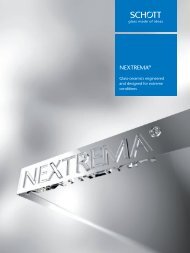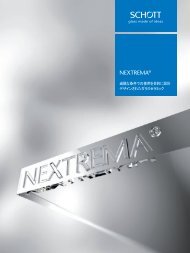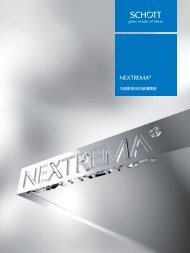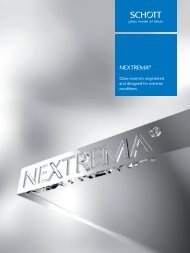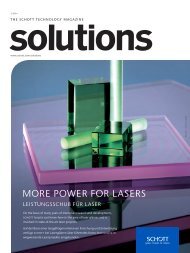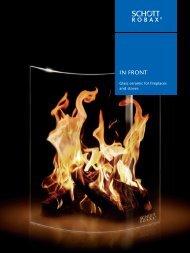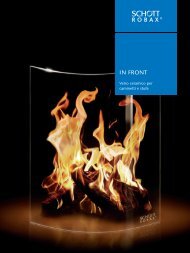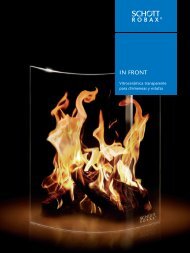SCHOTT Technical Glasses
Apart from its application in optics, glass as a technical material has exerted a formative influence on the development of important technological fields such as chemistry, pharmaceutics, automotive, optics, optoelectronics and information technology. SCHOTT Technical Glasses offers pertinent information in concise form. It contains general information for the determination and evaluation of important glass properties and also informs about specific chemical and physical characteristics and possible applications of the commercial technical glasses produced by SCHOTT. With this brochure, we hope to assist scientists, engineers, and designers in making the appropriate choice and make optimum use of SCHOTT products.
Apart from its application in optics, glass as a technical material has exerted a formative influence on the development of important technological fields such as chemistry, pharmaceutics, automotive, optics, optoelectronics and information technology. SCHOTT Technical Glasses offers pertinent information in concise form. It contains general information for the determination and evaluation of important glass properties and also informs about specific chemical and physical characteristics and possible applications of the commercial technical glasses produced by SCHOTT. With this brochure, we hope to assist scientists, engineers, and designers in making the appropriate choice and make optimum use of SCHOTT products.
Create successful ePaper yourself
Turn your PDF publications into a flip-book with our unique Google optimized e-Paper software.
58<br />
10. Glass-Ceramics for Industrial Applications<br />
and Home Appliances<br />
10.1 Introduction to glass-ceramics<br />
Glass-ceramics are distinguished from glass and ceramics by<br />
their characteristic manufacturing process (see Figure 45)<br />
and by their properties. Not classifiable as glass or as ceramic,<br />
they represent a completely new class of materials.<br />
They are manufactured in two principal production steps.<br />
In the first step, a batch of exactly defined composition is<br />
melted (as for normal glass). The composition is determined<br />
by the desired properties of the end-product as well as by<br />
the necessary working properties of the glass. After melting,<br />
shapes are produced by pressing, blowing, rolling or casting<br />
and then annealed. In this state, the material still exhibits<br />
all the typical characteristics of glass.<br />
In the second step, the “glassy” articles are subjected to a<br />
specific temperature-time treatment between 800 – 1200 °C<br />
(defined for each composition), by which they are ceramized,<br />
i.e. they are transformed into a mainly polycrystalline<br />
material. Apart from the crystalline phase with crystals of<br />
0.05 – 5 µm in size, this material contains a residual glass<br />
phase of 5 – 50 %.<br />
In the temperature range between 600 – 700 °C, small<br />
amounts of nucleating agents (e.g. TiO 2 , ZrO 2 or F) induce<br />
precipitation of crystal nuclei. As the temperature increases,<br />
crystals grow on these nuclei. Their type and properties<br />
as well as their number and size are predetermined by the<br />
glass composition and the annealing program. By appropriate<br />
program selection, either transparent, slightly opaque, or<br />
highly opaque, non-transparent glass-ceramics can be produced.<br />
Unlike conventional ceramics, these glass-ceramics<br />
are absolutely dense and pore-free. To achieve controlled<br />
ΔI/I in 10 –4 ––><br />
20<br />
15<br />
10<br />
5<br />
0<br />
Soda-lime glass<br />
DURAN ® /BOROFLOAT ® 33/<br />
SUPREMAX ®<br />
borosilicate glass<br />
“α-0”-glass-ceramics<br />
–5<br />
–200 0 200 400 600 800<br />
Temperature in °C ––><br />
Fig. 46. Thermal expansion of “α-0”-glass-ceramics compared to<br />
borosilicate glass 3.3 and soda-lime glass<br />
1800<br />
1600<br />
a<br />
C max<br />
Temperature in °C ––><br />
1400<br />
1200<br />
1000<br />
800<br />
600<br />
400<br />
200<br />
0<br />
b<br />
Fig. 45. Temperature-time schedule for glass-ceramic production<br />
a: melting, b: working, c: nucleation, d: crystallization,<br />
e: cooling to room temperature<br />
c<br />
d<br />
e<br />
Time ––><br />
Nucleation rate (N) and<br />
Crystal growth rate (C) resp. ––><br />
N<br />
N max<br />
C<br />
Temperature ––><br />
Fig. 47. Nucleation rate (N) and crystal growth rate (C) of glasses,<br />
related to temperature






